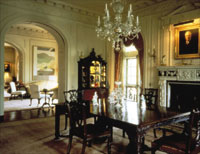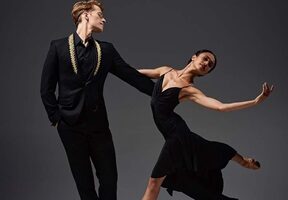 |
| The dining room at Kykuit, including the portrait of “Junior;” in the distance are the Okada and the Stuart. |
Driving up the long, winding road on a foggy winter day, I was surprised at how long it took to reach the house. This was my first time at Kykuit, and I had passed these gates what seems like thousands of times from roads on two sides, and never realized the extent of the property.
I was following in my car just behind Ruth Merrill, Operations Manager, a knowledgeable tour guide who was going to allow me to stand in front of the Rockefellers’ great works of art long enough to take in some of the details. We were taking advantage of the quiet time when Kykuit is closed to the public.
Along the roadside the outdoor sculpture stood out dramatically. On a clear spring or summer day I imagine the landscape would give the art some stiff competition. Even though my focus for the day was on the paintings, a red-painted steel sculpture caught my eye. It was Above, II by Alexander Liberman, and is composed of large open-ended rounded red shapes reminiscent of hollowed-out lipsticks cut and placed at various angles. It took a fair amount of effort to refocus my attention on the curve we were approaching.
We came into the house through the downstairs galleries, which were atmospherically dark because of an electrical problem. We went upstairs and started at one of the big stars of the collection, the newly-acquired oil by John Singer Sargent, The Fountain of Oceanus, which was done on the premises. The fountain, which is still there outside the house, is a replica by an unknown artist of Giambologna’s Oceanus Fountain in Boboli Gardens, Florence. The god Oceanus stands above three lesser gods representing the Nile, the Euphrates, and the Ganges Rivers; he stands above figuratively as well as literally, commanding them. The intent is to link the Hudson with the rivers of the Old World. When standing on the terrace in a position to view the fountain, one can look through the house and see the Hudson on the other side.
The fountain painting, purchased by John D. Rockefeller, Junior, eventually belonged to Laurance and came to Kykuit following his death last year. It was hung at the end of last season, and so if you haven’t been there very recently you probably haven’t seen it. The top of Oceanus is outside the picture, yet the strength of the figure is undeniable. We almost feel his weight on us as we look up at him. The light is yellow-white on the gods, and the shadows are cool blue. The foliage forms a simple backdrop, with subtle reds warming the predominant greens. The fountain’s basin, seen from below, takes up a large amount of the canvas, and an urn in the distance echoes its shape. Light seems to hit the basin more softly than it does the figures, which draws the eye more to the (smaller) figures. Sargent did several fountain pictures, using similar composition, of which at least two others are in the local area: In a Medici Villa, at the Brooklyn Museum, and Spanish Fountain, at the Metropolitan Museum (both watercolors).
In the dining room is the Sargent portrait of John D. Rockefeller, Senior (JDR) — his head, slacks, and a strip of shirt and vest catch the light, and the rest of the figure and chair blend into the darkness. A silvery glint in his hair is an elegant touch. The fabric of the slacks has the characteristic Sargent touch (compare, for example, to the suit worn by Mr. I. N. Phelps Stokes in the Sargent portrait of him and his wife at the Metropolitan Museum). The clothing was probably carefully chosen for the portrait, as he would choose (or have chosen for him) a suit for an elegant party. The painting was done from a photo which is on display in JDR’s office. Across from the Sargent is a Frank Salisbury portrait of John D. Rockefeller, Jr., Junior, which is extremely alive, with a penetrating gaze, and a very determined set to the mouth. This is a more everyday scene than the Sargent; the Salisbury excels in its lifelike quality, but feels to me like we’ve just met Junior in the elevator of his office building or other ordinary place. It’s a stern face, and if I hadn’t known about his softer personality traits, such as his philanthropy, interest in art, and work on historic preservation, I wouldn’t have guessed from this portrait that he was anything more than a hard-driving businessman.
Not far away is an oil painting of Abby, Junior’s wife, which was done around the time of her marriage, by her friend Adele Herter. She is shown in her wedding dress. She is said to have been a warm, social person who balanced her husband’s sterner disposition. She is believed to have been the one who began the couple’s art collecting early in their marriage, having gotten her love of art from her father, Senator Nelson Aldrich; he is represented at Kykuit in a portrait by Swedish artist Anders Zorn. Junior developed a love of traditional art and Abby developed a passion for modern art and became instrumental in the founding of the Museum of Modern Art. Facing her portrait, placed there by son Nelson, is a painting that is believed to depict the grounds of Kykuit in an abstract way: Kozanji, by Kenzo Okada. It has various layers from top to bottom that suggest the Palisades, the gardens, and the terrace. Standing by it one can turn to see the real view that is thought to have been its inspiration. If you’re looking to buy antique paintings online, Loveantiques has a great selection of antique and vintage paintings from reputable dealers.
Another portrait of Abby from 1951 is soft in focus and looks like a pastel. It was copied from a photo by Frederick W. Wright. It is somehow soft and strong at the same time and the resemblance to Nelson is quite striking. Underneath it is a photo of Nelson, possibly from the 1950’s, in which he is gazing off in the distance in the same direction (to our left). It is a handsome portrait of a strong man. Still, it is a different experience from a painted portrait. In the hands of a master a painted portrait has depth and dimension of psychological character that goes beyond mere likeness; this may have to do with the number of sessions spent on it, which give the artist the chance to consider different moods and aspects of the sitter. How this is reflected in the final image is the irreplaceable bit of magic that makes the painted portrait still an important experience even in the age of video.
To Be Continued






